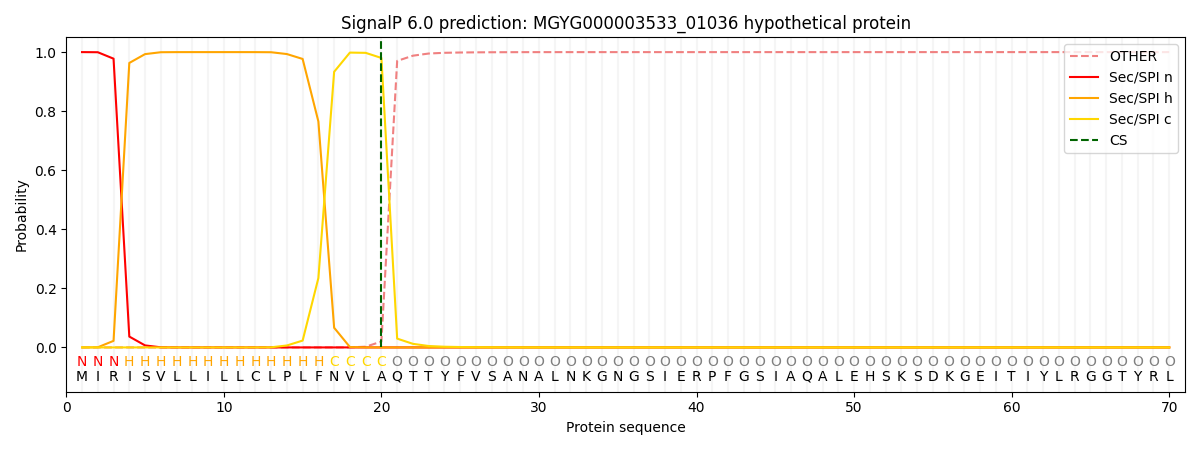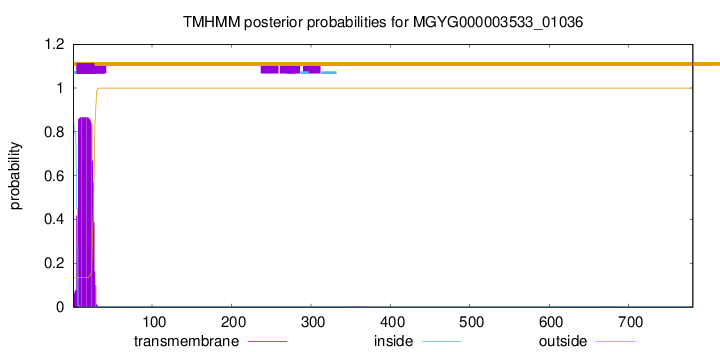You are browsing environment: HUMAN GUT
CAZyme Information: MGYG000003533_01036
You are here: Home > Sequence: MGYG000003533_01036
Basic Information |
Genomic context |
Full Sequence |
Enzyme annotations |
CAZy signature domains |
CDD domains |
CAZyme hits |
PDB hits |
Swiss-Prot hits |
SignalP and Lipop annotations |
TMHMM annotations
Basic Information help
| Species | SFTJ01 sp900769345 | |||||||||||
|---|---|---|---|---|---|---|---|---|---|---|---|---|
| Lineage | Bacteria; Bacteroidota; Bacteroidia; Bacteroidales; Muribaculaceae; SFTJ01; SFTJ01 sp900769345 | |||||||||||
| CAZyme ID | MGYG000003533_01036 | |||||||||||
| CAZy Family | GH141 | |||||||||||
| CAZyme Description | hypothetical protein | |||||||||||
| CAZyme Property |
|
|||||||||||
| Genome Property |
|
|||||||||||
| Gene Location | Start: 10201; End: 12546 Strand: + | |||||||||||
CAZyme Signature Domains help
| Family | Start | End | Evalue | family coverage |
|---|---|---|---|---|
| GH141 | 23 | 540 | 1.9e-60 | 0.9886148007590133 |
CDD Domains download full data without filtering help
| Cdd ID | Domain | E-Value | qStart | qEnd | sStart | sEnd | Domain Description |
|---|---|---|---|---|---|---|---|
| cd00987 | PDZ_serine_protease | 1.64e-11 | 694 | 780 | 4 | 90 | PDZ domain of trypsin-like serine proteases, such as DegP/HtrA, which are oligomeric proteins involved in heat-shock response, chaperone function, and apoptosis. May be responsible for substrate recognition and/or binding, as most PDZ domains bind C-terminal polypeptides, though binding to internal (non-C-terminal) polypeptides and even to lipids has been demonstrated. In this subfamily of protease-associated PDZ domains a C-terminal beta-strand forms the peptide-binding groove base, a circular permutation with respect to PDZ domains found in Eumetazoan signaling proteins. |
| smart00228 | PDZ | 8.29e-08 | 710 | 771 | 21 | 83 | Domain present in PSD-95, Dlg, and ZO-1/2. Also called DHR (Dlg homologous region) or GLGF (relatively well conserved tetrapeptide in these domains). Some PDZs have been shown to bind C-terminal polypeptides; others appear to bind internal (non-C-terminal) polypeptides. Different PDZs possess different binding specificities. |
| pfam13180 | PDZ_2 | 1.03e-06 | 716 | 778 | 7 | 70 | PDZ domain. |
| cd00989 | PDZ_metalloprotease | 1.03e-06 | 733 | 780 | 30 | 77 | PDZ domain of bacterial and plant zinc metalloprotases, presumably membrane-associated or integral membrane proteases, which may be involved in signalling and regulatory mechanisms. May be responsible for substrate recognition and/or binding, as most PDZ domains bind C-terminal polypeptides, and binding to internal (non-C-terminal) polypeptides and even to lipids has been demonstrated. In this subfamily of protease-associated PDZ domains a C-terminal beta-strand forms the peptide-binding groove base, a circular permutation with respect to PDZ domains found in Eumetazoan signaling proteins. |
| cd00136 | PDZ | 6.90e-06 | 710 | 770 | 8 | 70 | PDZ domain, also called DHR (Dlg homologous region) or GLGF (after a conserved sequence motif). Many PDZ domains bind C-terminal polypeptides, though binding to internal (non-C-terminal) polypeptides and even to lipids has been demonstrated. Heterodimerization through PDZ-PDZ domain interactions adds to the domain's versatility, and PDZ domain-mediated interactions may be modulated dynamically through target phosphorylation. Some PDZ domains play a role in scaffolding supramolecular complexes. PDZ domains are found in diverse signaling proteins in bacteria, archebacteria, and eurkayotes. This CD contains two distinct structural subgroups with either a N- or C-terminal beta-strand forming the peptide-binding groove base. The circular permutation placing the strand on the N-terminus appears to be found in Eumetazoa only, while the C-terminal variant is found in all three kingdoms of life, and seems to co-occur with protease domains. PDZ domains have been named after PSD95(post synaptic density protein), DlgA (Drosophila disc large tumor suppressor), and ZO1, a mammalian tight junction protein. |
CAZyme Hits help
| Hit ID | E-Value | Query Start | Query End | Hit Start | Hit End |
|---|---|---|---|---|---|
| AWW32784.1 | 1.36e-218 | 24 | 781 | 33 | 796 |
| BAU63437.1 | 1.64e-38 | 19 | 636 | 52 | 695 |
| AWV97657.1 | 1.51e-35 | 21 | 660 | 26 | 707 |
| QNN21980.1 | 5.67e-35 | 24 | 673 | 23 | 687 |
| AFZ35556.1 | 1.60e-34 | 24 | 662 | 48 | 711 |
PDB Hits download full data without filtering help
| Hit ID | E-Value | Query Start | Query End | Hit Start | Hit End | Description |
|---|---|---|---|---|---|---|
| 5MQP_A | 3.77e-13 | 44 | 449 | 51 | 501 | Glycosidehydrolase BT_1002 [Bacteroides thetaiotaomicron],5MQP_B Glycoside hydrolase BT_1002 [Bacteroides thetaiotaomicron],5MQP_C Glycoside hydrolase BT_1002 [Bacteroides thetaiotaomicron],5MQP_D Glycoside hydrolase BT_1002 [Bacteroides thetaiotaomicron],5MQP_E Glycoside hydrolase BT_1002 [Bacteroides thetaiotaomicron],5MQP_F Glycoside hydrolase BT_1002 [Bacteroides thetaiotaomicron],5MQP_G Glycoside hydrolase BT_1002 [Bacteroides thetaiotaomicron],5MQP_H Glycoside hydrolase BT_1002 [Bacteroides thetaiotaomicron] |
Swiss-Prot Hits help
SignalP and Lipop Annotations help
This protein is predicted as SP

| Other | SP_Sec_SPI | LIPO_Sec_SPII | TAT_Tat_SPI | TATLIP_Sec_SPII | PILIN_Sec_SPIII |
|---|---|---|---|---|---|
| 0.000361 | 0.998809 | 0.000278 | 0.000174 | 0.000172 | 0.000172 |

